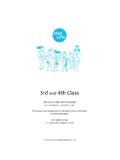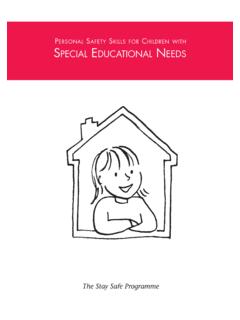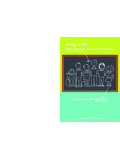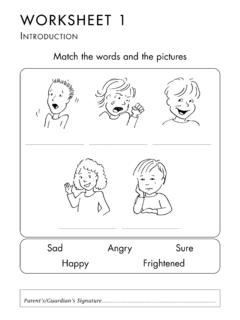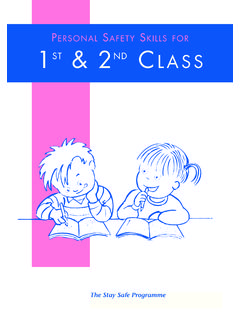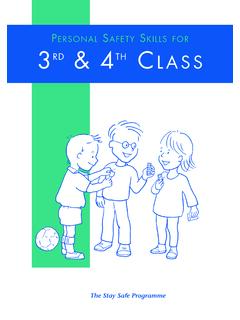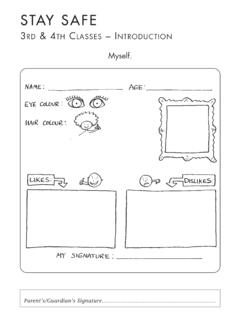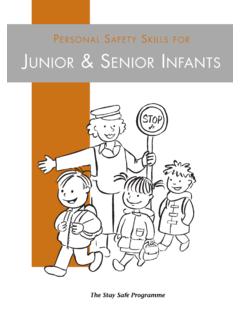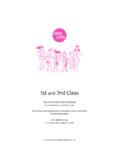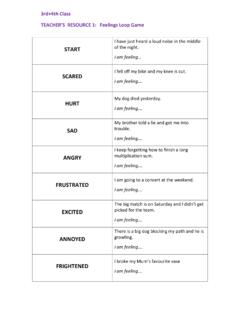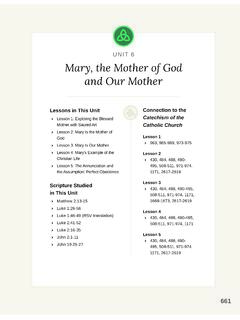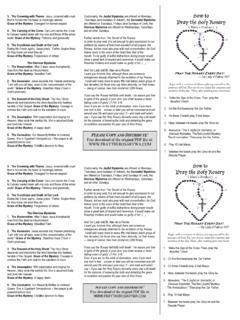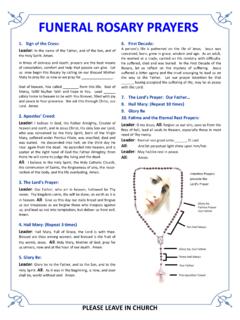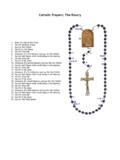Transcription of Junior and Senior Infants
1 Junior and Senior InfantsTHE STAY SAFE PROGRAMMEBy Deirdre MacIntyre and Maria Lawlor The content and development of this edition was co-ordinated by Patricia ShanahanFirst Published in 1991 This revised edition published in 2016 Child Abuse Prevention Programme 2016 Sincere thanks to all of those involved in the revision of the Stay Safe programme including: - The core development team of Patricia Shanahan. Marion Hefferon, Eimear Berry and Marion McHugh- Niamh Murphy, Anne Flynn, Deborah James and Maria Lawlor from the South Meath Cool School Anti Bullying team- Members of the PDST Health and Wellbeing team who assisted in the revision of content and resources- Kathleen McFadden who contributed many of the stories in these Teachers and children from St.
2 Gabriel s Convent School, Ballyfermot and Our Lady of Mercy Primary School, Sligo who participated in recording songs and audio visual material- Teachers and children who took part in the piloting of the revised programme- The Department Of Education and Skills Inspectorate for reviewing the material- The Department of Education and Skills for funding the publication of this Design by jean langley graphic design services 087 2249 752 Illustrations by Fintan TaiteAudio by Sound T AudioAcknowledgmentsStay Safe: A Teacher s GuideThe Stay Safe the Stay Safe ..11 Appendix A Sample Parent s Letter ..13 The Stay Safe LessonsIntegration Across the 1: Feeling Safe and Unsafe ..17 Topic 2: Friendship and Bullying.
3 31 Topic 3: Touches ..45 Topic 4: Secrets and Telling ..55 Topic 5: S GUIDE1 The Stay Safe programme is a personal safety skills programme for primary schools. The aim of the programme is to reduce vulnerability to child abuse and bullying through the provision of personal safety education for children and training for teachers, school management boards and parents. It is developmentally structured to enable primary school teachers to deliver an abuse prevention education that addresses personal safety issues such as physical, emotional and sexual abuse as well as bullying and stranger danger. About Feelings: To recognise the importance of feelings; how to express them appropriately and in particular to recognise unsafe feelings About Friendship: Making and keeping friends and the value of friendship About Bullying: What bullying is.
4 Strategies for dealing with bullying behaviour, and that it is never acceptable to bully others The importance of building confidence and self esteem How to identify and deal with inappropriate or unsafe touch That it is ok to say no to an adult in a situation where they feel unsafe, threatened or frightened To identify trusted adults whom they should tell if they are feeling frightened, threatened, worried or unsafe in any way To understand how someone might bribe, trick or threaten them to keep a secret It is never their fault if they are victimised or abused That they should never go anywhere with or take anything from a stranger Appropriate language for telling The Stay Safe rules: Say No, Get Away and Tell Never keep secrets about touch Never go anywhere with or take anything from a strangerThe importance of building confidence and self-esteem and developing assertiveness and strong clear communication is emphasised throughout the programme.
5 Children are taught that it is not their fault if they are bullied or Personal and Health Education Social, personal and health education (SPHE) provides particular opportunities to foster the personal development, health and well-being of the individual child, to help him/her to create and maintain supportive relationships and become an active and responsible citizen in society. Through an SPHE programme that is planned and consistent throughout the school, children can develop a framework of values, attitudes, understanding and skills that will inform their decisions and actions both now and in the future. Since SPHE has a moral and a spiritual dimension, its development and implementation are influenced significantly by the ethos or characteristic spirit of the school.
6 (SPHE Curriculum, p 2)All primary schools are required to fully implement the Stay Safe programme (DES circular 65/ 2011) within the context of the Social, Personal and Health Education curriculum. The implementation of the Stay Safe programme should be a collaborative process involving parents, teachers and the wider school community taking a co-ordinated approach to child protection and child abuse prevention through safety skills for the Stay Safe programmeChild abuse has no boundaries. It occurs at every socioeconomic level, crosses ethnic and cultural lines, and is found within all religions and at all levels of STAY SAFE PROGRAMMEA Teacher s GuideTEACHER S GUIDE2 Abused and neglected children can be found in almost every school in the country.
7 Research shows that more than half of the children who are abused and neglected are of a school going 2015 Annual Report from the Child and Family Agency, TUSLA shows that 43,596 referrals were made to Child Protection and Welfare Services in 2002 the SAVI report revealed that one in five women ( per cent) and one in six men ( per cent) reported experiencing contact sexual abuse in childhood. (SAVI, 2002) The 2014 Rape Crisis Network Ireland Report shows that: 63% of survivors who attended RCCs in 2014 disclosed that the sexual violence perpetrated against them happened when they were children. The majority of perpetrators of sexual violence are known to the person against whom they perpetrate the abuse (93%).
8 The vast majority of perpetrators of sexual violence against female and male victims were males (96%). A small number were combinations of males and females acting together (3%), or females acting alone (1%). Survivors who were under the age of 13 when the violence took place most commonly disclosed that the abusers were family members/relatives (45%). Almost one quarter of sexual violence against children under the age of 13 was perpetrated by other children (23%). 66% of child survivors attending RCCs first disclosed the abuse to role of schools in prevention education is increasingly being recognised as imperative to the reduction of vulnerabilities of children to abuse. Child abuse is a leading cause of emotional, behavioral, and health problems across the lifespan.
9 It is also preventable. School-based abuse prevention programs for early childhood and elementary school children have been found to be effective in increasing student knowledge and protective behaviors. (Brassard and Fiorvanti, 2015)As well as reducing children s vulnerability to abuse, the Stay Safe programme aims to increase wellbeing and resilience by giving children knowledge, skills and strategies in an age-appropriate manner, using developmentally structured lessons and resources to empower them. Research on the disclosure patterns of children showed that following their participation in the Stay Safe programme children were more likely to have purposively reported the abuse, were more likely to tell their teachers, and their reports were more likely to be substantiated (MacIntyre & Carr, 1999b).
10 Children with Special VulnerabilitiesDecades of research have established that children with specific vulnerabilities are more at risk of various types of abuse and victimisation. Factors associated with increased risk of child abuse include: The absence of one or both parents Use of alcohol or drugs in the family of victim Having a physical disability Being cared for by someone other than parents Having a learning disability Having social or emotional difficulties ( Davies & Jones, 2013; Putnam, 2003) Studies of perpetrators show that child abusers target vulnerable children who have certain traits, behaviours and characteristics that perpetrators feel they will be able to manipulate. Others seek out children with a disability, or a child who is isolated or cared for away from their immediate family.
